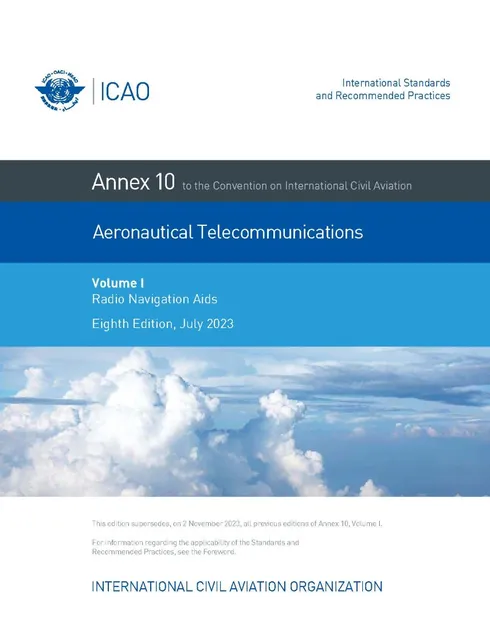Radio navigation aids provide pilots with vital information about their aircraft’s position, course and altitude. They offer precise and accurate guidance to pilots, enabling more efficient airspace management and helping to optimize air traffic routes and procedures. ICAO recently published the 8th Edition of Annex 10 – Aeronautical Telecommunications – Volume I – Radio Navigational Aids. This technical document defines, for international aircraft operations, the systems that need to be in place to provide radio navigation aids used by aircraft in all phases of flight.
The Standards and Recommended Practices (SARPs) and guidance material in this Volume outline the necessary specifications for radio navigation aids that include: the global navigation satellite system (GNSS), instrument landing system (ILS), microwave landing system (MLS), very high frequency (VHF) omnidirectional radio range (VOR), non-directional radio beacon (NDB) and distance measuring equipment (DME). This Volume covers essential aspects of power requirements, frequency, modulation, signal characteristics and monitoring needed to ensure that suitably equipped aircraft can receive navigation signals in all parts of the world with the requisite degree of reliability.
 Crucial for safe air navigation
Crucial for safe air navigation
Annex 10, Volume I addresses the technical requirements and specifications for radio navigational aids used in aviation. The main objectives are to:
- ensure the standardization of radio navigational aid systems worldwide to promote uniformity and enhance safety in international air navigation.
- provide guidance to Member States on the installation, operation, and maintenance of radio navigational aids to achieve consistent performance and reliability.
Supporting evolution in infrastructure
In keeping with the nature of aviation technology, this new edition of Annex 10, Volume I looks to the future. It supports the introduction of a dual-frequency, multi-constellation (DFMC) global navigation satellite system (GNSS) reflecting the ongoing evolution of the global GNSS infrastructure and facilitate its fruition by international civil aviation.
As part of the evolution, multiple GNSS constellations offering dual-frequency signals are being introduced into service by the United States (GPS modernization), the Russian Federation (GLONASS modernization), the European Union (Galileo constellation) and China (BeiDou Navigation Satellite System (BDS) constellation). DFMC GNSS offers an opportunity to further enhance GNSS robustness, navigation performance and operational benefits.
 Technical specifications and maintenance
Technical specifications and maintenance
Annex 10 Volume I details the technical specifications, installation requirements, maintenance procedures, and safety considerations for each type of radio navigational aid. These specifications help ensure that the systems are reliable, accurate, and compatible with each other, which is vital for seamless air navigation, especially in busy airspace with numerous aircraft. With radio navigation aid technologies continuously evolving, it is essential that Member States and aviation stakeholders follow the Standards and recommended practices in Annex 10 Volume I in order to implement these technologies.
It is worth noting that implementation of DFMC GNSS is not mandatory and will be driven by the specific cost/benefit and policy considerations that apply to individual States in consultation with aircraft and airport operators and international organizations.
The primary users of Annex 10, Volume I are local civil aviation authorities (CAAs) and air navigation service providers (ANSPs) who bear international obligations and responsibilities in regulating and facilitating safe and efficient flight operations. These regulatory bodies and service providers necessitate detailed information on radio navigation specifications, implementation guidelines, and training requirements. CAAs oversee the implementation of radio navigational aid systems with the support of manuals like Doc 8071, Doc 9613 and Doc 9849. ANSPs follow the guidance on the installation, operation, and maintenance of radio navigational aids to achieve consistent performance.
These specifications help ensure that the systems are reliable, accurate, and compatible with each other, which is vital for seamless air navigation, particularly in a busy airspace with numerous aircraft. From an industry standpoint, the primary target audiences for the provided information encompass aircraft operators, air traffic management personnel, and aviation training centers. These professionals rely on comprehensive information and guidelines to fulfil the installation requirements and maintenance procedures for operations and training on radio navigational aids.
Promoting safety, efficiency, and sustainability
Annex 10, Volume I is instrumental in maintaining a high standard of air navigation. By adhering to its guidelines, Member States and aviation stakeholders can improve safety and efficiency in international civil aviation operations. This contributes to more precise airspace management and more efficient routes and procedures, ultimately improving the safety, efficiency, and sustainability of international air transport. Available in English, Russian, French, and Spanish, this publication can be purchased in either printed or electronic formats. Interested parties can purchase it through the ICAO Store or alternatively explore its contents before making a purchase with the free online copy in English on ICAO’s eLibrary.


